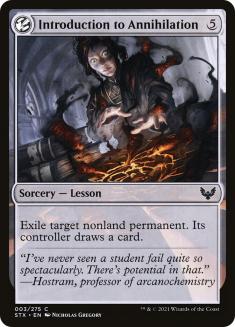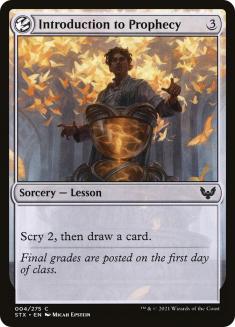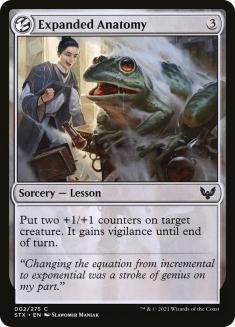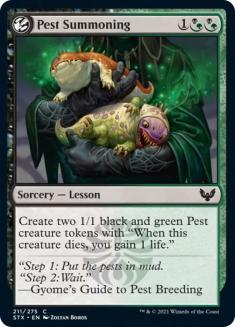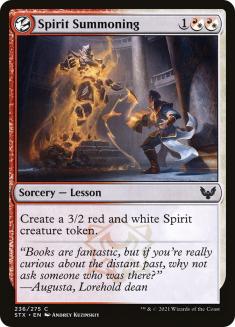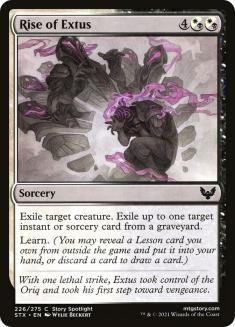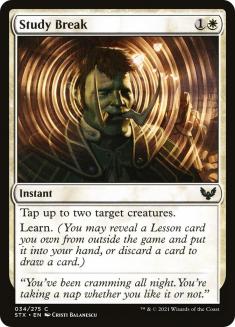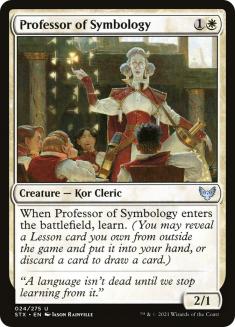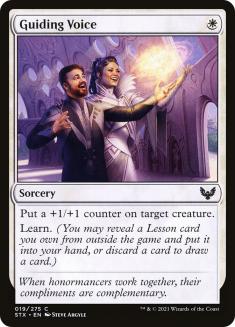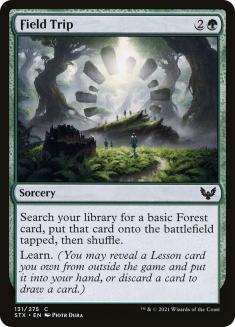The weeks before a new set releases will always be my favorite times of the year. There’s so much excitement and anticipation to hit the ground running once the set is live. Among the most challenging aspects of a new set to grapple with are the new mechanics and Strixhaven comes with some complicated ones. My goal today is to dissect everything I possible can about learn, and the corresponding Lesson subtype.
Learn. (You may reveal a Lesson card you own from outside the game and put it into your hand, or discard a card to draw a card.)
The first important concept to recognize with Learn is modality and it is surprisingly unbounded. Without any Lesson cards, this mechanic is an optional rummage. With a single Lesson, it’s a Charm with three options: rummage, draw that Lesson, or do nothing. However, with more Lessons in the sideboard, the options on the Charm grow more and more. It’s generally accepted that modal cards are the epitome of “the whole is greater than the sum of its parts,” meaning that all the modes can be below rate, but having a single card provide all the mediocre options makes that card valuable.
All of these Lessons are pretty atrocious. You know how Ravenform is bad in Kaldheim Limited? Well, add on two mana and upgrade a 1/1 Bird into drawing a card and that’s Introduction to Annihilation. The colorless flexibility does not make up for how bad the card is, but it does increase the number of decks that can have this card as part of a Lessons package, because you should never include it in your starting deck. Even though the card, on rate, is terrible, it’s almost exactly the type of card that can be acceptable as part of a modal spell.
There are battlefields where my opponent has a creature that will win them the game if it goes unanswered. In those circumstances, I’m happy to bite the bullet and cast a card as bad as Introduction to Annihilation to get me out of the situation. I would be unhappy if this were the only Lesson I had access to, because there will be many in-game situations where this card is worse than rummaging. However, with other lessons, it becomes a part of a toolkit.
What makes this card playable is a concept called coverage. A card that has “low coverage” is very narrow; its usefulness only covers a small set of possible game states. A card that has “high coverage” is useful or good in a large set of possible game states. All the Lessons pictured above have low coverage; however, they cover very different scenarios.
Introduction to Annihilation covers the situation where your opponent has a bomb. Expanded Anatomy covers the situation where you need to continue to push a stronger battlefield presence. Introduction to Prophecy covers the situation where the game is playing very slowly and victory will have nothing to do with pressure and everything to do with who draws their best cards first.
Observe that these three situations have minimal overlap. Hence, while all three cards are low-coverage, it’s possible that the option to have access to all of them on a card with the learn mechanic makes a high-coverage card.
As Lessons expand from colorless to hybrid, they become less situational. Pest Summoning and Spirit Summoning are below rate, yet can be ideal uses of learn when you just need to trade off with small creatures. Spirit Summoning will always be useful over the course of a game, but six mana for sorcery-speed removal is too inefficient to justify including in most Limited decks in this day and age. Still, again, this still helps paint the same picture. These cards are less narrow than the other Lessons, and hence help the learn mechanic achieve full coverage with a density of such Lessons.
This leads to the following questions, which I believe will be crucial to answer in order to succeed in this format:
- What package of Lessons yields full coverage?
- What is the correct way to balance drafting Lessons and cards with the learn mechanic to get enough copies of both?
The rest of this article will attempt to address the second question, because the first question is impossible to answer until the full set is previewed.
Once I looked at the cards with learn, I became confident that they’re just so much better than the Lessons. If you replace “Learn” with “draw a card” on the cards pictured above, they all look solid. Further, if you draft enough Lessons to have full coverage, I expect learn to be at least equivalent to a cantrip.
This shouldn’t come as a surprise because Lessons are meant to be excluded from your maindeck. If they designed the Lessons to be so good that it was correct to start them, the whole mechanic falls apart. In fact, this brings up a whole new concept that will define the proper way to prioritize Lessons and cards with learn — scarcity.
Scarcity is a concept I have written about before, and I often say it is fundamental to solving a format. The reason I listen to most Limited podcasts is not because they provide me with information I don’t already have (the content is great and they sometimes do, but it’s not why I listen). It’s because I know many other players listen to them, and knowing the information a large portion of players will hear influences the scarcity of cards in the format. It lets me better predict the behavior of the table.
Scarcity with respect to Lessons and cards with learn is a push-and-pull situation. If all the Lessons are high-priority, it’s hard to get enough for full coverage, which makes the learn cards much worse. This would be a huge fail with respect to game design because a main mechanic isn’t being leveraged.
Luckily, the cards with learn appear to be generally better than the Lessons, so it could be the other way around. If all the cards with learn become high-priority, all the Lessons become almost pointless to prioritize, as getting a density of cards with learn isn’t possible. However, this has a positive effect on the mechanic because the players who end up drafting cards with learn will always be able to get the right suite of Lessons to achieve full coverage.
Chances are, neither extreme scenario will be how the scarcity of the mechanic settles. But it does shed light that, generally speaking, cards with learn should be prioritized before Lessons are. Furthermore, the lower in priority learn is, the higher in priority Lessons are. This is an important observation because their evaluations will wax and wane. So remember — if some learn cards go from bad to good week to week, this can shift the whole format.
Environmental Sciences and Field Trip are the best cards with learn previewed so far and are great examples of cards that will vary in power level week to week. It’s very common for formats to have different speeds at different times. The first few weeks of Kaldheim Limited were sluggish. Everybody was playing multicolor snow decks with an abundance of taplands. Now, the format is quite fast. The best thing to do, according to the data, is Boros or white-base aggressive decks in general. And if you’re not playing a fast deck, you need to stock up on Ravenous Lindwurm to combat it.
Similarly, I expect multicolor decks to be enticing at some point in Strixhaven Limited. During this time, the value of Environmental Sciences and Field Trip will increase. When that time passes, their value will decrease. Both of these shifts will have rippling impact over priorities of many commons and the relationship between learn and Lesson will be a part of that due to scarcity and coverage.


